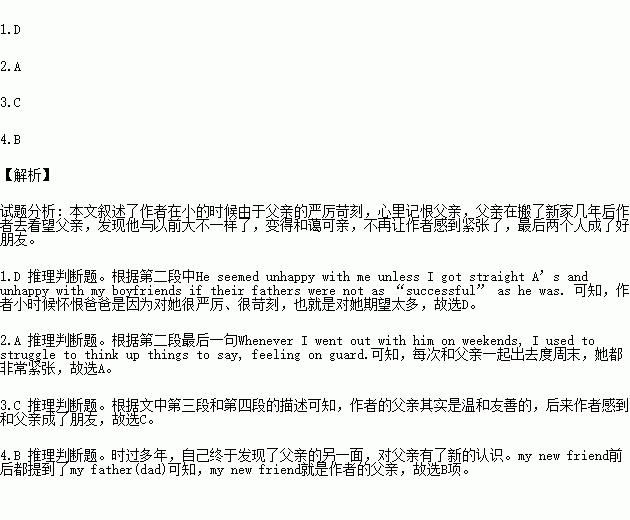题目内容
Last week my youngest son and I visited my father at his new home in Tucson, Arizona. He moved there a few years ago, and I was eager to see his new place and meet his friends.
My earliest memories of my father are a tall, handsome, successful man devoted to his work and his family, but uncomfortable with his children. As a child I loved him. He seemed unhappy with me unless I got straight A’s and unhappy with my boyfriends if their fathers were not as “successful” as he was. Whenever I went out with him on weekends, I used to struggle to think up things to say, feeling on guard(警惕).
On the first day of my visit, we went out with one of my father’s friends for lunch at an outdoor café. We talked along that afternoon, did some shopping, ate on the street table, and laughed over my son’s funny facial expressions. Gone was my father’s critical (挑剔的) air and strict rules. Who was this person I knew as my father, who seemed so friendly and interesting to be around? What had held him back before?
The next day dad pulled out his childhood pictures and told me quite a few stories about his own childhood. Although our times together became easier over the years, I never felt closer to him at that moment. After so many years, I’m at last seeing another side of my father. And in so doing, I’m delighted with my new friend. My dad, in his new home in Arizona, is back to me from where he was.
1.Why did the author feel bitter about her father as a young adult?
A. He was silent most of the time.
B. He was too proud of himself.
C. He did not love his children.
D. He expected too much of her.
2.When the author went out with her father on weekend, she would feel __________.
A. nervousB. sorryC. tiredD. safe
3.What does the author think of her father after her visit to Tucson?
A. More critical.B. More talkative.
C. Gentle and friendly.D. Strict and hard-working.
4.The underlined words “my new friend” in the last paragraph refer to __________.
A. the author’s son
B. the author’s father
C. the friend of the author’s father
D. the café owner

